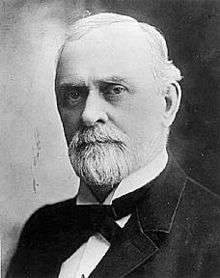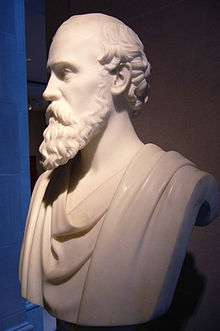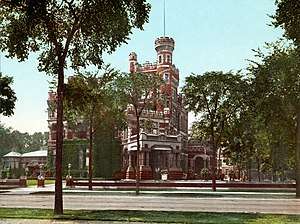Potter Palmer
Potter Palmer (May 20, 1826 – May 4, 1902) was an American businessman who was responsible for much of the development of State Street in Chicago. Born in Albany County, New York,[1] he was the fourth son of Benjamin and Rebecca (Potter) Palmer.[2]
Potter Palmer | |
|---|---|
 Potter Palmer | |
| Born | May 20, 1826 |
| Died | May 4, 1902 (aged 75) |
| Occupation | Chicago businessman, developer |
| Known for | Building the Palmer House Hotel, Widening State Street, Changing the city's downtown orientation, Developing the majority of State Street, Building the Palmer Mansion, developing Marshall Field & Co. |
Retailing career
Potter Palmer founded a dry goods store, Potter Palmer and Company, on Lake Street in Chicago in 1852. Unlike many stores of the time it focused on women and encouraged their patronage. Palmer instituted a "no questions asked" returns policy and allowed customers to take goods home to inspect before purchasing, which served to nurture the goodwill and patronage of Chicagoans. He made the store much larger and more distinctive than other stores of the time. Palmer was the first owner to advertise with large window displays that included price comparisons.
When Palmer's doctor urged him to get out of the business in 1865 because of ill health, he brought in partners Marshall Field and Levi Leiter. The trio joined forces and renamed the firm Field, Palmer, Leiter and Company. The store would eventually develop into the prominent Midwestern department store chain Marshall Field and Company.
Real estate career

In 1867, Palmer sold his share of the partnership and focused his efforts on his real estate interests, leasing a new building to his former partners in 1868 at State and Washington. He built several buildings along State Street on property he owned, including the Palmer House Hotel. When his buildings were destroyed in the Great Chicago Fire, Palmer borrowed $1.7 million to rebuild, the largest amount lent to a private individual up to that time. He reclaimed the swampland north of Chicago's commercial district, developing it into Lake Shore Drive.[3] Potter Palmer also moved the city's main commercial district from Lake Street, which ran east and west, to State Street, which ran north and south, parallel with the lake the way Chicago's downtown is currently oriented. Potter Palmer is also responsible for widening State Street.
Personal life

In 1871, he married Bertha Honoré. In 1874 a son, Honoré, was born; in 1875, Potter Palmer II. Both went on to have sons named Potter Palmer III, as well as other children.[4]
In 1885 Palmer built the castle-like Palmer Mansion on Lake Shore Drive, leading to the establishment of the Gold Coast. Prior to that time, Prairie Avenue had been the most desirable address in Chicago.
Palmer is buried in Graceland Cemetery in the north side neighborhood, known today as Uptown, Chicago.
References
- "Death of Potter Palmer" in The New York Times, May 5, 1902, p. 9.
- "Potter Palmer." Dictionary of American Biography. New York: Charles Scribner's Sons, 1936. Biography in Context. Web. 30 Apr. 2014.
- Miller, Donald L. (1997-04-03). City of the Century: The Epic of Chicago and the Making of America. Simon and Schuster. ISBN 9780684831381.
- Who's Who in Chicago, 1931
Further information
- City of the Century: The Epic of Chicago and the Making of America
- Love Under Fire: The Story of Bertha and Potter Palmer, 2013 half-hour documentary
- Ross, Ishbel (1960). Silhouette in Diamonds: The Life of Mrs. Potter Palmer. New York: Harper. ISBN 9780405069345.